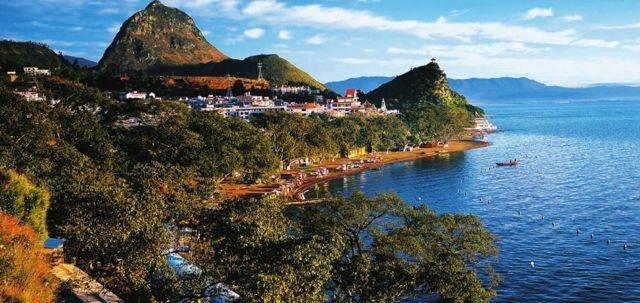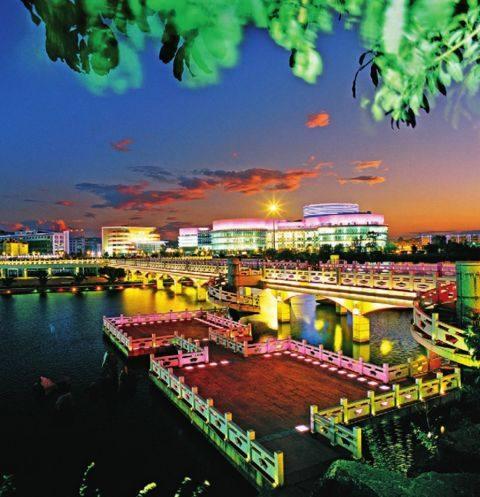Yuxi—Home of Humanity’s Ancestor and China’s Heroes
By WU MEILING
IF Vienna is the spiritual home to the masters of classical music, then Yuxi might enjoy the same accolade for modern musicians. This is because it is the birthplace of Nie Er (1912-1935), composer of the national anthem of the Peoples Republic of China.
Yuxis connotations reach beyond music to human life on earth in general. The Yuanmou Man (homo erectus yuanmouensis) archaeological site in Chuxiong Autonomous Prefecture, believed to be one of the earliest human settlements, dates back 2.5 million years. But the group of mollusk fossils excavated in Maotianshan of Yuxi unlocks secrets from 530 million years ago. It was here that the Naraoia fossil, which is the com- mon ancestor of all reptiles and mammals, was found.
War and Peace
Located in the hinterland of Yunnan Province, Yuxi, a city with a long history, is known as Yunnans “heart of jade.” Yuxi was seat of the Baipu Kingdom in Chinas Shang and Zhou dynasties (1600-256 BC), and around 2,000 years ago was the center of the ancient Dian Kingdom. It was a prosperous flourishing capital of diverse ethnic cultures until its collapse during the Three Kingdoms Period (220-280) and Wei, Jin, Southern and Northern Dynasties(220-589). The Erhai region then took up its mantle as political, cultural and economic center of Yunnan, and Yuxi fell into obscurity.
After a millennium of peace, inten- sive war in the spirit of national defense erupted in Yuxi in the form of the Chongjiu Rebellion. When the call for national salvation from Japanese aggression was the theme of the era, the bravery of armies from Yuxi fighting Japanese aggression earned them honor throughout the nation. It was at this crucial time that Yuxis young musician Nie Er composed the inspiring March of the Volunteers, as sung by soldiers and residents of the Shaanxi-Gansu-Ningxia Border Area and Shanxi-Chahar-Hebei Base Area. The 200th Division of the National Revolutionary Army, whose brave resistance to Japanese aggression won them fame and honor, made it their battle hymn.
White to Red
Although Nie Er has gone, his memory lives on. Zhiyin Lake in Yuxis Nie Er Park is in the shape of a violin. A bronze statue of Nie Er in a conducting posture stands on a black jade plinth there, as his compositions resound throughout the square.
The red pagoda, the most prominent landmark of Yuxi, can be seen from every corner of the city, earning it the reputation of “one origin and four homes,”the former meaning the origin of life– as in the 530-million-year-old palaeontological fossil excavated in Maotian Mountain, Chengjiang County – and the latter referring to Yuxi as the birthplace of Nie Er and the home of Yunnan tobacco, of the Lantern Festival, and of the rivers and lakes on the plateau.
Climbing the red steps up Hongta(Red Pagoda) Mountain, I felt as though I was experiencing the half-century history of the Hongta Group. Built in the Yuan Dynasty (1271-1368), the Hongta(Red Pagoda) was originally called the Baita (White Pagoda). In earlier times the spectacular view of the White Pagoda at sunset was famous throughout China. In the late Qing Dynasty (1644-1911), war and turbulence left Baita (White Pagoda) Mountain bleak and desolate.
The Yuxi Cigarette Factory was founded in 1958. At that time, when red flags fluttered throughout China, Yuxi Cigarette Factory workers painted the White Pagoda red and renamed it the Red Pagoda. There is a haunting poem inscribed at the foot of Hongta Mountain, telling its tale of prosperity:
“Red pagoda, green waters,
Fairies envy Yuxi natives.”
Mountain Caravans
Mountains form the backbone of Yunnan.
Situated within the combined belt of two first-level geotectonic units, Yuxi has a complicated geologic structure. Karst topography, fluvial and tectonic landforms and other ancient geological movements have contributed to Yuxis striking and diverse landscapes.
Ailao Mountain, Mopan Mountain, and Liangwang Mountain appear as stilts supporting Yuxi. Most famous among them is Ailao Mountain, which I went to see one foggy morning.
Ailao Mountain Nature Reserve in Xinping County is the natural and geologic combination of the Yunnan-Guizhou Plateau, Hengduan Ranges, and south side of the Qinghai-Tibet Plateau. The largest mountain range west of the Yunnan-Guizhou Plateau, Ailao Mountain is also the junction of the East Asian Tropical Monsoon and South Asian Tropical Monsoon. The 400-kilometerlong “green dragon” that Ailao Mountain resembles tempers the climate in Yun- nan and contributes a scattering of green cities throughout the province. In 1998, Ailao Mountain was listed a UNESCO“Man and the Biosphere Programme”forest ecosystem observation station.
Ailao Mountains best known scenic spots include the Nanen Waterfalls, the Ancient Tea-Horse Trail, Shimen Gorge, the Longxi Clan Mansions, and Jinshan Pass, all of which are near Gasa Town.
The Ancient Tea-Horse Trail on Ailao Mountain is a good place to start a sightseeing trip in Yuxi. This time-honored scenic route, with its millennia-old flagstones and hoof prints amid fallen leaves and moss, connect the ancient and modern, yesterday and today.
Abundant ancient trees frame the sky, and flowers fragrance and bird song accentuate the mountains forest tranquility. The Tea-Horse Trail on Ailao Mountain was one of three in ancient times. Among them the Yinan Route to Dali and Ailao Mountain started in Puer. After the Ming Dynasty (1368-1644), the Yinan Route started from Yunnans capital, Kunming, and extended through Laos and Thailand, so becoming both the official and business route connecting Yunan with central China and countries beyond the southern border.
The Yinan Route was once known as the southern “Silk Road.” Traveled since the Tang Dynasty (618-907), it flourished from the Song Dynasty (960-1279) to the Qing Dynasty (1644-1911), and reached its pinnacle during the Republic of China period (1912-1949). Before the establishment of the Peoples Republic of China, at least 800 horses and mules and 1,000 traders daily trod this route. Ailao Mountains name signifies a place where there are wild beasts, such as tigers, leopards and pythons, as well as fist sized mosquitos, and also gorgeous flowers and butterflies. In former times, this mountainous route resounded with the clip clop of horse caravans. What they carried and their encounters are recorded on the flagstones along the way.
Nanen Waterfall and Shimen Gorge are neighboring attractions on the mountain. Nanen in the Dai language means “silver water.” In the wet season the falls thunder as they cascade 100 meters from a huge rock slab can be heard several kilometers away. Beside the main waterfall are the Cixiongjian Falls, the Lienü Falls, the Shouweng Falls, and others, all of which form a rare and magnificent group of waterfalls. After walking less than a kilometer from Nanen Waterfall I arrived in Shimen Gorge, also known as Ailao Mountains Jiuzhaigou (a nature reserve and national park located in northern Sichuan Province).
Shimen Gorge, flanked by cliffs and with a river running through it, is noted for its various natural rock crosscuts. There are more than 10 within two kilometers, the first to the last within less than a 100-meter drop. A plank road at the valley entrance leads to the mountain top, and giant trees and craggy rocks filter the suns rays. Visitors making their way to the summit can enjoy as they walk the beauty of deep emerald streams and the scents of flowers and ferns. I happened to meet at the third rock crosscut a group of Dai girls. Dressed in traditional Huayao wear, distinctive for the several meter long rainbow-tinted cummerbund wound around the waist, these young Dai women enhanced the beauty of the entire valley.
I must say that although Yuxis Mopan and Liangwang mountains are striking, I most admire Xiushan Mountain in Tonghai. In the Ming and Qing dynas- ties, Xiushan Mountain had the honor of being named “Best Landscape in Southern Yunnan” and, along with Jinma Mountain and Biji Mountain in Kunming, and Diancang Mountain in Dali, being counted among Yunnans Four Famous Mountains. Ming Dynasty travel writer and geographer Xu Xiake (1587-1641) once wrote of Xiushan Mountain:“Speaking of magnificent mountains, I believe Tonghai, which is in Yidong Circuit, is the best.” Xiushan Mountain is thus a historical attraction. More than 2,060 meters high, it was developed and its temples and gardens built in the Han Dynasty (202 B.C. - A.D. 220). During the Yuan (1279-1368), Ming (1368-1644) and Qing (1644-1911) dynasties it was a Buddhist shrine. Comprising 64 separate buildings, the ancient temple complex includes Puguang Temple, Qingliangtai, and Yongjin Temple and Bailong Temple. All the constructions are elaborate, delicate, and distinct from each other with striking architectural features signifying the era in which they were built. There are plaques inscribed with couplets on almost every pavilion and shrine ranging from the Han to the Qing dynasties. Small but exquisite Xiushan Mountain is thus site of the largest number of couplets of any in China.

More than 200 years ago, an official wrote a poem after returning to his hometown upon his retirement:
The lonely city overlooking water, its back against a mountain,
Reminds me of the rainy season in Jiangnan.
The mountain in the poem is Xiushan Mountain (Jiangnan refers to regions south of the Yangtze River) which was a cultural paradise in the Ming and Qing dynasties. The poem thus signifies the strong cultural connotations of this frontier mountain.
Lakes, the Spirit of Yuxi
Fuxian, Xingyun, and Qilu lakes in Yuxi are among the nine most beautiful lakes in Yunnan.
Fuxian Lake is the largest lake at the source of the Pearl River (Zhujiang). Fuxian means “supporting fairies.” Legend has it that the immortals Xiao and Shi once stood beside one another in a boat among the rocks on southeast Fuxian Lake, their arms around one anothers shoulders as their shadow loomed over the lake surface.
Aside from its incomparable beauty, Fuxian Lake is also the deepest alpine freshwater lake in China. Wide to its north and narrowing to its southern banks, its shape is like a calabash.
The lake covers an area of 216 square kilometers, and is hence Yunnans largest-capacity water resource. With a capacity of 20.6 billion cubic meters, Fuxian holds 12 times the amount of water of Dianchi Lake and 6 times that of Erhai Lake. Best of all, Fuxian Lake is unpolluted. The lake water is category one drinking water, with a diaphaneity of seven to 10 meters.
Fuxian Lake has a magnificent coastal landscape which includes the “Four Ancient Views and Four Unique Views.”
The first ancient view is the paleontological fossil group excavated in Maotian Mountain that is a manifestation of the Cambrian Explosion, and unlocks the mystery of lifes origins. It is acknowledged as the most striking archaeological excavation of the 20th century.
The second ancient view is the Ancient Yunnan Bronze Culture excavated in Lijia Mountain, Jiangchuan County, and site of more than 200 ancient tombs. Only 85 have been excavated,and unexpectedly found to contain more than 5,000 items of bronze ware.
The third ancient view is that of the ruins of an ancient submerged city in Fuxian Lake. Archeologists are still undecided on whether the city is site of an ancient Dian Kingdom, or of an emperors tomb, or the site of Yuyuan County of the Western Han Dynasty(206 B.C.- A.D. 24 ). They remain mystified after almost 10 years of underwater explorations that include constant and unaccountable discoveries. Two sunlike images and one item of architecture resembling an Egyptian pyramid have given rise to suspicions that aliens might have a hand in this architectural complex on the lakebed, which is larger even than the capital city of the ancient Dian Kingdom.
As for the lakes “Four Unique Views,”I mention just one – the mystical big fish and the mackerel shoal.
Large fish lives in Fuxian Lakes depths, according to local residents. How large? Some say larger than a man, others say larger than a door or as big as a yacht. On July 29, 1992, a peasant named Zhang Zhiliang finally hooked a 1.56-meter-long, 64 kilogram mackerel. Experts say it is the largest fish ever caught from a freshwater lake in China. Strange to say that the day after this big catch, shoals of fish converged at the spot where the jumbo mackerel had been caught. They appeared to be in desperately search of something.
The mackerel shoal has been photographed twice. Locals spotted in the summer of 1981 a giant shoal of thousands of fish. Among them was a fish described as bigger than a cow. More than 10 meters long, mackerel and whitefish acted as its body guards in a neat and spectacular formation, like officials accompanying an emperor on an imperial tour.
Upon arrival at Fuxian Lake I witnessed spectacular sights on its white beach of magnificently dressed couples posing for wedding photographs. The deep blue water, clear sky, and beach conjured the ambience of being by the sea. “Watch the sunrise,” “enjoy fishing in the afternoon,” “overlook the lake view in the evening,” and “appreciate the moon” are charming views that have been popular since the Song Dynasty(960-1279). All can be seen today at Fuxian Lake. A visit to this scenic lake is a chance to explore its mysteries while luxuriating in its lake and beach scenery.
The Homesick of Southern China
Many ethnic minority groups, including the Yi, Dai, Hani, Lahu, Bai, Miao, and Hui, live in Yuxi. There are consequently diverse festivals here throughout the year. They include the Huayao Dai Huajie Festival (a festival for young lovers) in Xinping, the Yi Torch Festival in Eshan, the Hani Shiyuenian Festival (the most important festival for Hani people, similar to the Han Spring Festival) in Yuanjiang, and the Mongol Yizu (commemorating ancestors) Festival, the latter of which came as a surprise to me. I knew people of various ethnic groups lived in Yuxi, but I had no idea that there was a Mongolian Autonomous County— Xingmeng County — in the very south of China. Its history goes back to 1253, when the grandson of Genghis Khan(1162-1227) conquered Yunnan with an army of 100,000 soldiers, many of whom later settled in Yunnan. In 1381, when the Yuan Empires rule of Yunnan ended, Mongolian officers who had guarded Qutuoguan escaped from Ming army attacks and survived to be the only Mongolian community daring to retain their names and ethnic dress.
My schedule was too tight to visit this community. But I admire the people of this ethnic group, who retain the dream of their native grasslands. Over the past 700 years, many have probably returned to their home beyond the Great Wall in their dreams. Galloping home on horseback should be the endeavor of every generation. But their dreams seldom come true.
Yuxi is the freshest ink and wash painting in Yunnan Province, and deserves the time it takes for full appreciation.

